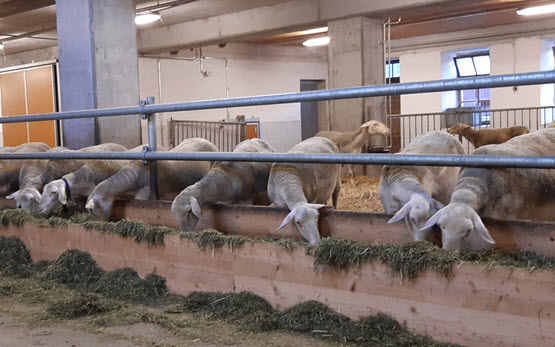Dairy sheep and goats pick their favourite components out of mixed rations, thereby substantially altering the composition of the feed within a short space of time. This makes the use of mixed rations for small ruminants challenging.
In intensive milk production, each animal in the herd is meant to receive a high-quality, needs-based ration. Mixed rations are often used for this purpose for dairy cows, as they cannot select them.
Are mixed rations suitable for small ruminants?
For intensive milk production, mixed rations are also increasingly used in the case of sheep and goats. Experimental studies on 24 dairy sheep and 24 dairy goats tested whether sheep and goats can select mixed rations. It was found that both dairy sheep and dairy goats always looked for the longer particles and substantially altered the ration within just a few hours. Dairy sheep also increasingly select for crude protein. Cutting the ration components short was able to delay the selection somewhat, but not prevent it.
The results clearly demonstrate how small ruminants are capable of adapting the food source according to their needs.
Single feed is preferred
If grass silage or hay was fed on its own, similar quantities of both were consumed, but not the mixture of both. The project made it clear that goats and sheep did not have a preference for mixed rations, and that feed selection is most likely a behavioural need of sheep and goats.
More feeding places per animal ensure feed quality for lower-ranking animals
At the same time, feeding and social behaviour were investigated, since sheep are strongly synchronous in their behaviour and goats enforce rank very strictly. Both can make access to feed more difficult.
With morning feed distribution, almost all the animals were at the feed axis. Sheep behaved somewhat more synchronously than the goats over the period afterwards. Goats had somewhat more confrontations at the feeding place than the sheep. The number of confrontations about feed decreased for both species the more feeding places were available per animal. Since mixed rations are selected and feed quality decreases quickly, all animals must be able to feed simultaneously when the feed is distributed.
5-times-daily feeding reduces conflict
In addition, six dairy-sheep farms looked at what happened when feeding frequency was increased from once or twice daily to five times daily. When feed was distributed 5 times daily there were always more animals feeding at the same time, and there were fewer disputes about feed. Multiple feed distributions over the day help ensure that feed quality does not decrease too sharply and that competition for feed is reduced. Automatic feed distribution would be ideal to decrease workload in this respect.






